
© Denise Hasse / iStock / Getty Images Plus / Getty Images.
Fences are useful boundary markers and can add value and visual appeal to your property. The key is choosing the right style of fence for your purposes: confining livestock, marking your front yard boundary, or creating privacy and security in the garden. This guide helps you explore and compare different fencing styles.
On This Page:
- How to Choose the Best Fence Designs
- Different Fence Styles
- Wood Fence Styles
- Metal Fences
- Vinyl Fence Styles
- Composite Fencing
- Wire Fences
- Best Fence Designs Compared
How to Choose the Best Fence Designs
Selecting the right fence depends on its purpose and your desired outdoor aesthetic. For example, while a beautiful white picket fence is an American classic, it doesn’t offer much in terms of security. Consider these key factors before you decide.
- Budget: Your budget is central in influencing which fence you buy. Figure out your spending limit and how many linear feet of fencing you need to work out your budget per linear foot, as fencing costs can quickly add up.
- Durability: Consider strength, lifespan, resistance to pests, rot and fungus, rust, and the material’s ability to withstand local weather conditions.
- Maintenance: Maintenance, cleaning and repairs should be simple and minimal.
- Purpose: The style of fence you choose should be suitable for its intended purpose.
- Installation: Find out what installation requirements, such as foundations or supports, are necessary. Research if DIY is possible or if professional installation is your only option.
Ready to start your Fencing Project?
Find ProsDifferent Fence Styles
With five main types of fence materials and many styles, you need a firm grasp of each to make the right decision. For example, if you’re looking for a classically attractive boundary marker for your front yard, wooden picket fencing could be the best option. Alternatively, if security is your primary concern, opt for a wrought iron fencing design.

© emmgunn / E+ /Getty Images.
Wood Fence Styles
Wood fence styles range from traditional to contemporary and from purely functional to attractive and decorative.
Lattice Fences
Lattice fences are affordable and decorative. You can use them as privacy fences by growing dense foliage over them.
Pros:
- Options suitable for all budgets. Lattice fencing costs $3.50–$30 per linear foot
- Plant-friendly and promotes upward growth
- Aesthetically pleasing
- Works well in conjunction with other fencing
- Most lattice fencing is prefabricated cedar or bamboo for easy installation
Cons:
- On its own, lattice fencing provides little privacy but can be used with other fence panels or trailing plants to provide a privacy screen
- Not particularly durable
Vertical Board Fences
Vertical board fences are the most common type of residential fence. There are budget-friendly options available as well as higher-end panels. Vertical board fences are affordable choices for basic privacy and security fences.
Pros:
- Budget-friendly: $7–$15 per linear foot
- Sturdy and durable. The fence boards don’t sag, particularly if made from high-quality wood such as redwood or ipe
- Work well on uneven ground and can be stepped if necessary to accommodate uneven terrain
- Easy to build and install
- Available in prefabricated panels
- Protects against wind
Cons:
- Water and ice easily damage the board ends
- Usually plain and utilitarian in appearance
Picket Fences
The picket fence conjures up cozy images of traditional properties with carefully tended lawns. They’re good for demarcating a property boundary but don’t provide much security.
Pros:
- Inexpensive: Picket fencing costs $3–$30 per linear foot
- Takes painting and staining well
- Environmentally friendly if sustainably sourced. Biodegradable and individual pickets can be recycled and reused
Cons:
- Requires regular maintenance and repairs
- Prone to moisture damage and rot without proper sealing and care
- Susceptible to warping and sinking
- Not good for privacy or security
Post-and-Rail Fences
Post-and-rail fences are a solid choice for making a boundary over a large area, as material use is minimal. However, they don’t provide any security or privacy.
Pros:
- Affordable: Post-and-rail fences cost $4–$12 per linear foot
- Has a quaint, rustic appearance
- Sturdy enough to fence in livestock
- Requires minimal care and maintenance
Cons:
- Does not provide privacy or security
- Pets can easily escape
- Wildlife can easily get through the fence
Ready to start your Fencing Project?
Find Pros
© ballycroy / E+ /Getty Images.
Metal Fences
Metal fences are generally stronger and more secure than other materials. You can choose from highly ornate and secure metalwork or simple but functional wire. For the higher-end options, which are often costly, homeowners often reduce costs per square foot by combining the metal with brick.
Wrought Iron Fences
Wrought iron fences have a high-end, timeless look. While costly, they’re extremely strong and, with a little care, will last a lifetime.
Pros:
- Strong and durable
- Unbeatable lifespan
- Solid, reliable security barrier
- Stair stepping allows use on mild gradients
Cons:
- Expensive: Wrought iron fencing costs $24–$34 per linear foot
- Requires regular maintenance including inspecting and patching the finish to avoid rust
- Not suitable for steep slopes or very uneven terrain
Aluminum Fences
Aluminum fencing is an attractive, more affordable alternative to wrought iron. Although it has a similar appearance, it’s not as strong as wrought iron.
Pros:
- Inexpensive options are available: costs $7–$40 per linear foot
- Doesn’t rust and is easy to clean with a regular garden hose
- Versatile and decorative
- Easy to install
- Environmentally friendly if made from recycled aluminum
- Recyclable
Cons:
- Not suitable as a privacy fence
- Not the most secure choice; because it’s so lightweight, it’s not as strong as steel or iron
Steel Fences
Steel is a strong, long-lasting fencing option that’s good for creating a secure barrier around your home.
Pros:
- Moderately priced (for metal): Steel fencing costs $7–$32 per linear foot
- Strong and long-lasting
- Can be racked or stepped for use on uneven terrain
- Resistant to rust if galvanized and finished with a powder coating
- Resists insects
- Heat and fire resistant
- Easy to clean
Cons
- Heavy, so transportation and storage are difficult
- Shouldn’t be installed near ocean due to salt water damage
- Lacks privacy

© ghornephoto / E+ /Getty Images.
Vinyl Fence Styles
An alternative to traditional wooden fence styles, vinyl fencing made from PVC comes in a range of styles, including those that mimic real wood.
Pros:
- Does not rot
- Does not crack or splinter
- Impervious to insect and water damage
- Available in many styles, from little pickets to tall privacy fences
Cons:
- Comparatively expensive: Vinyl fencing costs between $10–$30 per linear foot
- Not ideal for security fences
- Not particularly strong
- Prone to snapping, warping or buckling in extreme weather
Ready to start your Fencing Project?
Find ProsComposite Fencing
Composite fencing is an amalgamation of wood fibers, pulp or sawdust and ground plastic particles that are bonded and held together by an acrylic resin. It looks and feels like real wood and is an environmentally friendly choice, as it usually contains a high percentage of recycled materials.
Pros:
- Low-maintenance
- Easy to clean and can withstand pressure washing
- Eco-friendly choice, as it consists of recycled materials diverted from landfills
- Mimics real wood
- Requires no staining, sealing or painting
- Resistant to termites, other pests, rot and fungus
- Does not expand and contract with temperature fluctuations
Cons:
- Expensive: Composite fencing costs $22–$38 per linear foot
- Color may fade over time
- Susceptible to stains from spills

© Mieszko9 / iStock / Getty Images Plus /Getty Images.
Wire Fences
Wire fences are not made to enhance the aesthetics of your property, although some homeowners opt for black fencing to help boost aesthetics They are inexpensive, purely functional products suitable for DIY or professional installation.
Chain Link Fences
Chain link fences have been an inexpensive fencing solution for decades. They’re not pretty, but they are effective—particularly for keeping pets in and wildlife out.
Pros:
- Inexpensive: Chain link fencing costs $5–$20 per linear foot
- Suitable for DIY installation, though professional installation can give you a tighter, more durable fence
- Safe and effective containment, providing it’s tall enough
- Low maintenance
Cons:
- Won’t add to the value of your property
- No privacy
- Not suitable as security fencing
- Does not add aesthetic appeal
Barbed Wire Fences
Barbed wire fencing isn’t common in residential settings. While it’s an inexpensive, fierce and intimidating security deterrent, it isn’t attractive and will not add value to your home.
Pros
- Low-cost: Barbed wire fencing costs $0.50–$0.70 per linear foot. Remember to account for the number of strands you want, plus the posts you’ll need for securing the wire
- Visually intimidating
- Good for farm fencing
Cons
- Can cause injury
- No privacy
- Security is limited, as barbed wire is easy to cut and it can be climbed if covered
- Not attractive
Ready to start your Fencing Project?
Find ProsBest Fence Designs Compared
Whether you want to keep your livestock contained or enhance your property with an aesthetically pleasing, ultra-modern boundary fence, it’s important to understand the best fence options for each application. If you’re unsure, talk to a local fencing installer to discuss your options, or hire a fencing pro to give you a quote and advice.
Best Garden Fence Types
Vertical board fences are a smart choice for garden fences. They’re solid and, if installed correctly, have no gaps—so they keep pets and children in and wildlife out. They’re affordable and can be stair-stepped if you have uneven ground at the edges of your garden.
Best Privacy Fence Designs
Vertical board fences are a smart option for privacy fences, as they’re solid and tall enough to stop people looking over or peeking through the boards. Plain panels are very affordable. Or, for a high-end, decorative look, you can opt for a tropical hardwood vertical fence such as batu or ipe. A local privacy fence specialist can help you decide on the best material and design.
Best Security Fence Design
Steel fences or wrought iron fences are unbeatable for security fencing. Both of these options are incredibly strong with long lifespans. Different heights, styles and finishes are available, and they’re easy to maintain as long as you check the finish and repair any damage to avoid rust. These options are more expensive than wood, vinyl and other materials, but if security is your primary concern, these are your best choices.
Best Modern Fencing Options
Lattice fencing, aluminum and composite fencing are all solid options for modern fencing, with plenty of contemporary styles and colors for you to choose from. Aluminum and composite will, depending on the style you choose, give you more security and privacy than standalone lattice, but lattice is easy to combine with other fencing types for a unique, privacy-focused modern design.
Best Front Yard Fencing Options
Picket fencing is a great choice for your front yard if you’re looking for an affordable, easy-to-install classic. It’s a tidy boundary marker that adds quaint charm to your front yard. However, if you want more privacy or security, you’d be better off with short vertical boards or decorative composite.
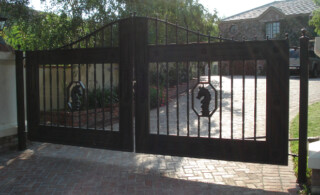 Material Issue: Wood and Metal Gates
Material Issue: Wood and Metal Gates 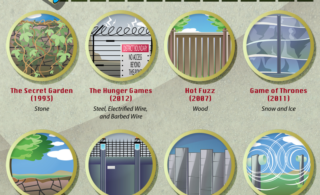 24 Famous Walls & Fences from Fiction
24 Famous Walls & Fences from Fiction 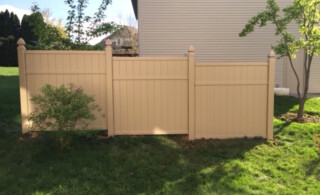 Fence Installation Checklist
Fence Installation Checklist 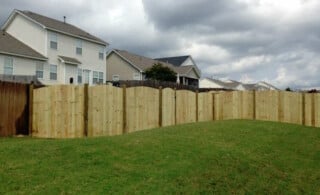 Wood Fence Options
Wood Fence Options 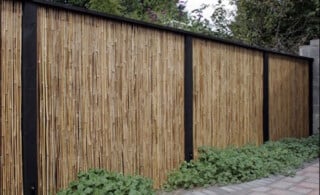 Go Green with Bamboo Fence
Go Green with Bamboo Fence 

I’m researching the types of materials for fencing and it seems there are quite a few options. I like the convenience and durability of aluminum and vinyl and the fact that it can be made to look like other materials, like wood. Although, if I have the choice I think cedar would be my first option for fencing supplies.
Thank you for the help. I am hoping to install a fence in my yard sometime this year. I have not decided what material I should use yet. I like the idea of vinyl, as you mentioned. Do you think that is one of the most durable options?
Very crucial to go over the rules, regulations, and property lines in your neighborhood. Some can be strict and frankly annoying, but most contractors will work with you to find a satisfactory solution. The last thing you want is to build a beautiful fence that brings along fines and ends up being taken down! Very useful article here for homeowners looking to have a fence installed.